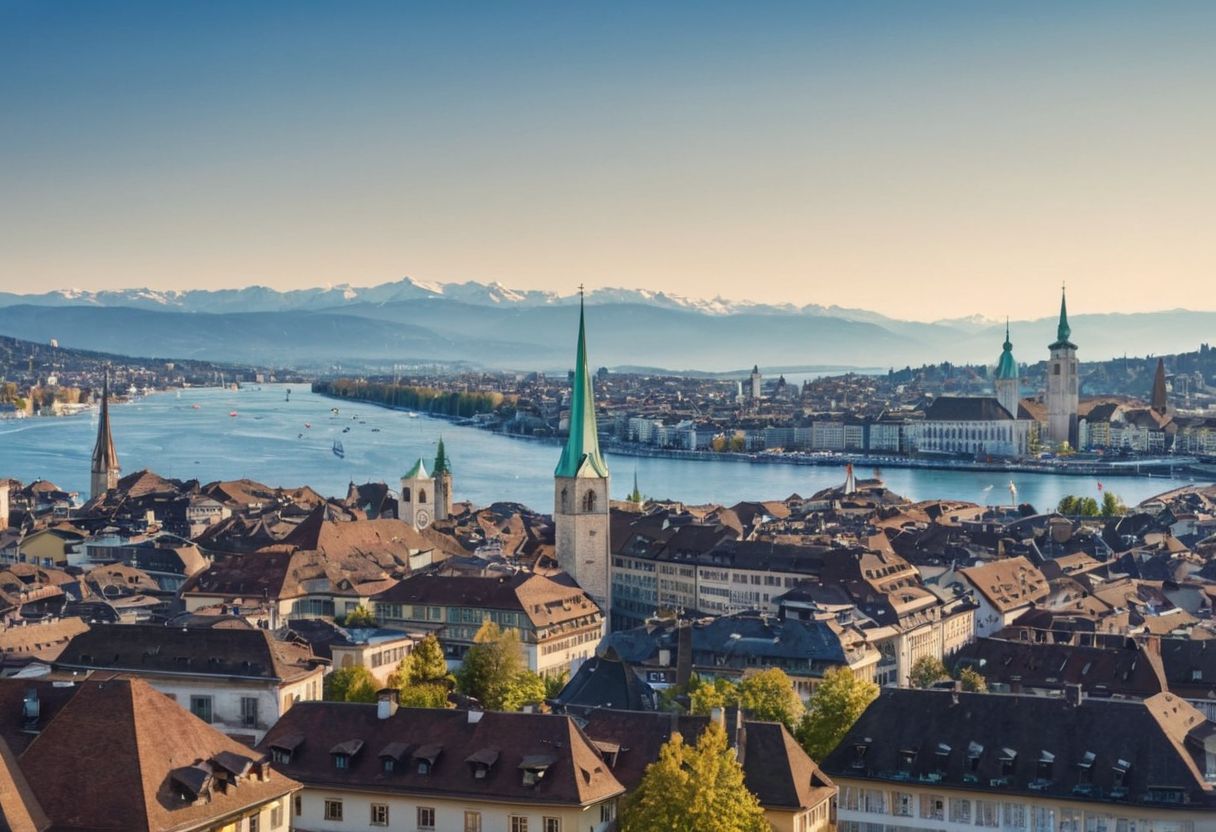Have you ever wondered what secrets lie in the cobbled streets of Zurich’s Old Town?
Navigating the rich history of an ancient city can be overwhelming without a guide.
Zurich’s Old Town, known as the historic centre of the city, is a treasure trove of narrow streets, historic buildings, and significant cultural sites including the Fraumünster, Grossmünster, and Peterskirche.
Our blog post will take you on a captivating journey through time, exploring Old Zurich’s Roman roots, Medieval influences, economic transformations, and its evolution into a modern cultural hub, complete with essential travel tips and crowd management strategies.
Roman Turicum: Uncovering Old Zurich’s Ancient Roots

The ancient roots of Zurich, known as Roman Turicum, trace back to when it was a modest settlement on the edge of the Roman Empire. Archaeological findings suggest that Turicum, despite being bypassed by the main northeast road of the empire, played a significant role as a customs point. Here, goods transported between the Walensee and Lake Zurich were taxed, showcasing its strategic importance in trade and military pathways.
Over time, Turicum evolved from a small village into a bustling Roman vicus, marked by the development of public baths, a citadel on Lindenhof hill, and various residential and craft buildings. The remnants of this era, including graves, craft sites, and everyday objects, offer a glimpse into the daily life and industry of ancient Zurich. These artefacts continue to surface during modern-day excavations, particularly in the Altstadt area, highlighting Zurich’s continuous historical significance.
The Church’s Influence in Medieval Zurich
During the early Middle Ages, the church played a pivotal role in shaping the social and political landscape of Zurich. The establishment of convents and monasteries, such as the Fraumünster Abbey, founded by Ludwig the German in the 9th century, became centres of power and influence. These religious institutions not only served spiritual needs but also became significant landowners and contributors to the city’s governance.
The influence of the church extended beyond mere ownership and spiritual guidance. It was instrumental in:
- Educating the populace, providing literacy and learning to a largely agrarian society.
- Mediating conflicts and acting as a stabilising force during turbulent times.
- Promoting art and culture, which can still be seen in the architecture and historical records of Zurich. This ecclesiastical dominance set the stage for future cultural and political shifts, including the Reformation.
Zurich’s Emergence as a Free City
Zurich’s journey to becoming a free city began in 1218 when the House of Zähringen’s rule ended. This significant event marked Zurich’s initial steps towards autonomy, setting the foundation for its future as an independent entity. The city’s strategic location on key European trade routes facilitated its economic and political ascent, attracting traders and settlers who contributed to its growth and prosperity.
In 1336, the adoption of a constitution based on the guild system further empowered Zurich. This democratic framework balanced the influence of crafts, trades, and the nobility, fostering a more equitable distribution of power. By 1400, Zurich had successfully purchased its freedom from the emperor, a bold move that eliminated tax obligations and solidified its status as an imperial free city.
The Guild Revolution: Shaping Zurich’s Future
The guild revolution in 1336 marked a pivotal shift in Zurich’s governance. Nobleman Rudolf Brun led what was known as the “craftsmen’s revolution,” which effectively transferred power from local politicians to the guilds. This change not only altered the political landscape but also emphasized the importance of trades and crafts in shaping the city’s future.
The guilds, originally comprising various trades and communities, became central to Zurich’s economic and political decision-making. They introduced a democratic framework that balanced the power among crafts, trades, and the nobility. This system:
- Fostered economic development by supporting local tradespeople
- Enhanced social cohesion by involving more citizens in governance
- Ensured a fair distribution of power, which contributed to the city’s stability and growth
Reformation in Zurich: A Crucial Turning Point
The Reformation marked a pivotal era in Zurich’s history, beginning in 1519 when Huldrych Zwingli took up his role at the Grossmünster. This period was crucial as it not only transformed the religious landscape but also had profound impacts on social and political structures. Zwingli’s radical preachings, advocating for the removal of indulgences and the simplification of religious practices, resonated deeply with Zurich’s citizens.
The acceptance of Reformation ideals by the Zurich Council in 1523 catalysed significant changes. Key outcomes included:
- The dissolution of monasteries, redirecting wealth towards public welfare
- Reduction in individual financial burdens, previously exacerbated by church-imposed expenses
This shift not only altered the church’s role but also redistributed economic power within the city, setting the stage for modern governance and community structures.
Cultural Flourishing in 18th Century Zurich
The 18th century marked a period of significant cultural flourishing in Zurich. This era witnessed the rise of influential literary figures and the spread of enlightening ideas that enriched the city’s intellectual atmosphere. The establishment of societies dedicated to arts and sciences further stimulated this cultural expansion, making Zurich a beacon of enlightenment and creativity in the region.
During this period, Zurich became a hub for theatrical and musical advancements. The city’s opera house began hosting performances that drew crowds from across Europe. Key developments included:
- The introduction of new musical styles and compositions
- The staging of plays that reflected Zurich’s evolving societal values
- Public lectures and discussions that promoted literary and philosophical exchanges
Tracing Economic Growth in Zurich
Zurich’s economic trajectory has been marked by several transformative phases, each contributing to its status as a dynamic city. From its medieval trade roots to becoming a hub for banking and finance in the 19th century, Zurich’s economic landscape has continuously evolved, adapting to the changing needs and opportunities of its time.
The city’s economic growth was significantly boosted by the industrial revolution, which saw the rise of factories and railroads. This period not only expanded Zurich’s industrial base but also established it as a critical node in Switzerland’s economic network. Furthermore, the development of the service sector in the 20th century, especially in banking and financial services, propelled Zurich into a modern economic powerhouse.
Zurich as a Modern Economic Centre

Today, Zurich stands as a modern economic centre, renowned for its global financial services and robust scientific research. The city hosts numerous multinational corporations and is home to world-class educational institutions like the Swiss Federal Institute of Technology. This blend of commerce, science, and culture makes Zurich a pivotal economic hub in Europe.
Essential Travel Information for Zurich
When visiting Zurich, it’s vital to understand how to navigate the city efficiently. Public transportation is highly recommended as it connects all major attractions seamlessly. Key points include: – Always purchase and validate your transport tickets, available at numerous vending machines and through the SBB app. – Consider a day pass if planning multiple journeys, as it covers all modes of transport including trams, buses, and boats on the Limmat.
For must-see locations, the Zurich Opera House and the quaint streets of Old Town are unmissable. The Opera House offers a glimpse into Zurich’s rich cultural scene, while the Old Town, with its historic buildings and cobbled lanes, provides a deep dive into the city’s past. Both spots are perfect for experiencing the essence of Zurich.
Exploring the Surroundings of Zurich
Venturing beyond the heart of Zurich opens up a treasure trove of scenic landscapes and historical sites. For instance, the Polybahn, a charming funicular railway, offers a quick ascent from Central to the ETH terrace, where breathtaking views of the Old Town await. This spot is perfect for those looking to capture Zurich’s beauty from above.
Another enchanting location is the Old Botanical Garden, nestled near the Schanzengraben canal. Here, visitors can explore:
- Tucked-away paths
- A quaint glass pavilion
- Benches perfect for quiet reflection
This garden provides a serene escape from the bustling city centre.
Managing Crowds in Zurich: Tips and Predictions
Managing crowds effectively in Zurich, especially in popular areas like the Old Town, requires a combination of forecasting techniques and real-time adjustments. Predictive tools, such as crowd-sensing IoT devices, can estimate the number of visitors based on historical data and current trends. This information helps in preparing for high-traffic periods by adjusting resources accordingly.
On-the-ground strategies include:
- Digital signage to direct flows or suggest alternative routes
- Real-time updates via mobile apps about crowded areas
- Staff deployment to manage and assist crowds
These methods ensure a smoother travel experience, helping visitors to enjoy Zurich’s attractions without the discomfort of overcrowding.
Enhance Your Old Zurich Experience with INDULGE
Enhancing your journey through Old Zurich isn’t just about sightseeing; it’s about diving deep into its culinary heritage with INDULGE. Their expert-led food tours in Old Town offer a unique blend of historical insights and gastronomic delights, making every step a delicious discovery of Zurich’s past and present.
With INDULGE, you can expect to:
- Taste traditional Swiss dishes that have been staples in Zurich for centuries.
- Learn how these culinary practices are interwoven with Zurich’s historical events and cultural shifts.
- Enjoy the atmospheric settings of Old Zurich, where every meal tells a story, enriching your overall experience of the city.








